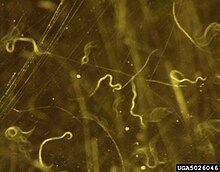Foliar nematode

Foliar , causing brown to black, vein-delimited lesions on leaf tissue, defoliation, and possible stunting of plants.
Biology
While many plant parasitic
Inside the leaves of plants female nematodes lay one or two eggs a day, with each female producing up to 25 to 30 eggs. The generation time from egg to adult is finished in 10–14 days, with eggs hatching in 3 to 4 days, and nematodes maturing after 6–12 days. This rapid generation time allows populations to quickly grow, sometimes reaching thousands of nematodes per leaf
Adult foliar nematodes are able to overwinter by surviving in dried plant tissue in a dormant state. The nematodes can survive in this dead leaf material for several months. Foliar nematodes do not survive for very long in bare soil alone.
Dispersal
Foliar nematodes occur throughout the
Control
Presently, there are very few control options for plants infested with foliar nematodes. The current recommendations are to destroy infected plant material, and avoid using overhead irrigation to prevent the spread of nematodes to new plants.
References
- PMID 33158287.
